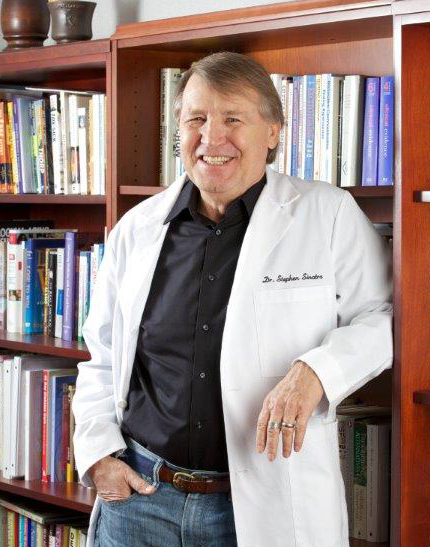By Stephen T. Sinatra, M.D., F.A.C.C., F.A.C.N., C.N.S., C.B.T.
Targeted Supplements for the Heart
Supplementation with what I’ve nicknamed, the “awesome foursome,” is the most targeted way of sustaining your heart’s energy needs. Supplements enhance health at the cellular level and provide nutrients necessary for metabolic processes. The “awesome foursome,” consisting of coenzyme Q10 (CoQ10), L-carnitine, D-ribose, and magnesium, individually and collectively help increase energy, or ATP, production in your body by supporting mitochondria within cells.
Everyone needs a sustained and healthy pool of ATP to fuel bodily functions. Cells require large amounts of ATP to contract and relax the heart, maintain cellular ion balance, and synthesize macromolecules like proteins and fats. Your body generates ATP de novo as well as recycles it through a process called oxidative phosphorylation. A much faster process than synthesizing ATP from scratch, recycling is the preferred method of energy production. Eighty to ninety percent of ATP is recycled in the mitochondria, then released into the fluid portion of cells to be used for energy.
Mitochondria require each of the “awesome foursome” to generate ATP. While CoQ10 and L-carnitine are fundamental to the ATP recycling process, D-ribose is necessary for de novo ATP synthesis. Metaphorically, D-ribose helps fill the body’s gas tank while L-carnitine and CoQ10 help the body convert fuel to energy. Literally, D-ribose is a structural component of the ATP molecule, and L-carnitine and CoQ10 help recycle ATP by transporting fatty acids across mitochondrial membranes and shuttling electrons back and forth between enzymes, respectively. Co-Q10 then acts as an antioxidant to protect mitochondrial membranes from free-radical damage. Like a spark plug central to both processes, magnesium “turns on” the enzymes that drive the entire metabolic reaction.
Supplementation Helps Prevent “Revolving-Door Medicine”
Depending on the individual, supplementation with any or all of the “awesome foursome” may be the key to maintaining energy and supporting overall health. At around age forty, endogenous production of CoQ10 and L-carnitine generally starts to decrease, explaining why people commonly associate lack of energy with “middle age.”
People suffering from coronary artery disease (CAD) often can’t keep up with the heart’s energy demands. With CAD, the heart continually overworks to pump blood through inflamed and congested blood vessels and ultimately expends energy must faster than the mitochondria can produce it.
If you take pharmaceutical drugs for CVD, you should also supplement with some or all of the “awesome foursome” to prevent nutrient deficiency. Beta blockers, for example, which prove effective in stabilizing people during emergency situations and improving symptoms, inhibit the production of enzymes necessary for CoQ10 synthesis. Since their long term use can impair your ability to make ATP, adjunctive supplementation with CoQ10 can counteract pharmaceutical side effects associated with energy depletion.
Most cardiologists want to avoid practicing “revolving-door medicine,” or repeatedly seeing the same patients come in with the same life-endangering problems. To make this happen, physicians and patients need to do something which moves beyond symptoms of the disease and gets to the “heart of the matter.” Complimenting pharmaceutical treatments with nutritional supports is one way that practitioners can treat symptoms and make a real difference in the underlying pathology of illness (emotional work and stress management are additional means).
Already native to your body, any of all of the “awesome foursome” can safely and effectively be ingested in tandem with cardiac drugs like beta-blockers, calcium channel blockers, nitrates, and ACE inhibitors. Not only will taking energy-enhancing supplements help alleviate negative side effects associated with these drugs, but it might eventually reduce, or even eliminate, your need for such medication.
Please note: although drug interactions are not likely, they are possible. Always consult with your physician before adding nutraceuticals to the program if you are currently taking pharmaceutical drugs for any cardiac condition.
In a nutshell
A healthy ATP energy pool can help keep you feeling youthful. While you can’t take ATP as a pill or vitamin, you can give your body the next best thing: substances with which it can make ATP. Supplementing with the “awesome foursome,” can help boost ATP production and support heart health. By directing nutrition to the cellular level, you can improve your quality of life, especially if you’re taking pharmaceutical medications and/or living with a cardiovascular condition.
People with heart disease often exhibit CoQ10, L-carnitine, D-ribose, and/or magnesium deficiencies. Failing hearts lack adequate energy to drive pump function. As the heart is one of the most responsive organs in the body for targeted nutritional supplementation, practicing metabolic cardiology is a must. By enhancing ATP synthesis and recycling, and promoting more efficient metabolism in mitochondria, the “awesome foursome” helps support heart health. Taking some or all of the “awesome foursome” adjunctive to pharmaceutical treatment can benefit those with a broad spectrum of cardiac conditions like angina, congestive heart failure, ventricular arrhythmia, hypertension, and high cholesterol. Patients should always consult with their physicians before adding nutritional supplements to a pharmacologic program.
Each of these nutrients plays a fundamental role in cellular metabolism, especially in supplying the heart with the energy it needs to preserve its contractile force. While each is independently effective in helping hearts work through the stress of disease, the “awesome foursome,” together, are synergistic.
For more information about the “awesome foursome” and ATP production, check out articles in the Metabolic Cardiology section, as well as my books:
© 2015 HeartMD Institute. All rights reserved.











